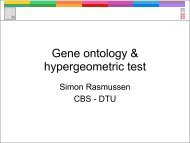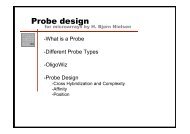Computational tools and Interoperability in Comparative ... - CBS
Computational tools and Interoperability in Comparative ... - CBS
Computational tools and Interoperability in Comparative ... - CBS
You also want an ePaper? Increase the reach of your titles
YUMPU automatically turns print PDFs into web optimized ePapers that Google loves.
endonuclease. The occurrence of RM systems that are not<br />
shared between the stra<strong>in</strong>s suggests that new RM systems<br />
are readily acquired <strong>and</strong> subsequently lost as a result of<br />
mutation or recomb<strong>in</strong>ation (L<strong>in</strong> et al. 2001). But that these<br />
would pose restriction barriers <strong>in</strong> gene flow is difficult to<br />
envisage with the dynamic population structure. RM genes<br />
possibly have other advantages to the cell. For methylation<br />
genes miss<strong>in</strong>g their match<strong>in</strong>g restriction gene, it has been<br />
suggested that they may be used for regulat<strong>in</strong>g gene<br />
expression (as for DAM methylation <strong>in</strong> E. coli; Lobner-<br />
Olesen et al. 2005; Robb<strong>in</strong>s-Manke et al. 2005) <strong>and</strong> for<br />
keep<strong>in</strong>g track of which parts of the chromosome have been<br />
recently replicated (Maas 2004).<br />
Methods for compar<strong>in</strong>g bacterial genomes<br />
There are at least 20 methods to compare bacterial<br />
genomes, as shown <strong>in</strong> Table 3. Some methods are more<br />
commonly used than the others, <strong>and</strong> it is beyond the scope<br />
of this review to provide a detailed analysis of each<br />
method. A few of these methods are discussed <strong>in</strong> this<br />
section.<br />
Chromosome alignment <strong>and</strong> size comparison<br />
Perhaps one of the easiest ways to compare genomes is by<br />
their sizes, as shown <strong>in</strong> Fig. 5. Although different phyla<br />
have different average sizes, it must be kept <strong>in</strong> m<strong>in</strong>d that<br />
many of the phyla have currently few representatives <strong>and</strong><br />
that there is a strong economic bias towards sequenc<strong>in</strong>g the<br />
smallest genome, so the size distributions shown here for<br />
the sequenced genomes could well be shorter than what<br />
Table 3 Approaches to compar<strong>in</strong>g bacterial genomes<br />
exist <strong>in</strong> natural ecosystems. Another way of compar<strong>in</strong>g<br />
chromosomes is to do a simple alignment of the DNA<br />
sequences. There are two versions of the alignment<br />
programmes. One <strong>in</strong>volves download<strong>in</strong>g some scripts<br />
<strong>and</strong> runn<strong>in</strong>g them on a local computer such as the Sanger<br />
Centre’s (Cambridge, UK) Artemis Comparison Tool<br />
(ACT, Carver et al. 2005) <strong>and</strong> the other is web-based<br />
such as “WebACT”, a web-based version of ACT with precomputed<br />
comparisons between several hundred bacterial<br />
genomes. The latter might be easier to use for those<br />
biologists who are less computationally <strong>in</strong>cl<strong>in</strong>ed (Abbott et<br />
al. 2005).<br />
AT content <strong>in</strong> genomes <strong>and</strong> promoter analysis<br />
Another relatively easy method to compare genomes is by<br />
their AT content, which ranges from 78% (Wigglesworthia<br />
gloss<strong>in</strong>idia) to 27% (Clavibacter michiganensis) for the<br />
300 genomes sequenced at the time of writ<strong>in</strong>g. In addition<br />
to the average AT content for a whole genome, if the<br />
variation of the AT content with<strong>in</strong> a given genome is<br />
exam<strong>in</strong>ed, two general trends can be seen for nearly all of<br />
the bacterial genomes. First, on a more global chromosomal<br />
level, there is a tendency for the region around the<br />
orig<strong>in</strong> of DNA replication to be more GC rich (i.e. less AT<br />
rich) <strong>and</strong> the region around the replication term<strong>in</strong>us to be<br />
more AT rich (Hall<strong>in</strong> et al. 2004b). Second, the average AT<br />
content for DNA about 400 bp upstream of the translation<br />
start site for all the genes <strong>in</strong> a genome is higher than 400 bp<br />
downstream (Hall<strong>in</strong> et al. 2004b). This makes sense <strong>in</strong> that<br />
the DNA will need to melt more easily <strong>in</strong> order for<br />
transcription to start.<br />
Level Method Reference<br />
Genome Chromosome alignment Carver et al. 2005<br />
AT content <strong>in</strong> the genome <strong>and</strong> upstream of genes Ussery <strong>and</strong> Hall<strong>in</strong> 2004a<br />
Oligomer bias on lead<strong>in</strong>g or lagg<strong>in</strong>g str<strong>and</strong>s Worn<strong>in</strong>g et al. 2006<br />
Repeats (local <strong>and</strong> global) Ussery et al. 2004a<br />
Periodicity of DNA structural properties Worn<strong>in</strong>g et al. 2000<br />
Length comparison Ussery <strong>and</strong> Hall<strong>in</strong> 2004b<br />
Promoter analysis Ussery et al. 2004d<br />
Transcriptome Organisation of rRNA operons Ussery et al. 2004b<br />
tRNAs <strong>and</strong> codon usage Ussery et al. 2004c<br />
Third nucleotide position bias <strong>in</strong> codon usage Ussery et al. 2004c<br />
Annotation quality Skovgaard et al. 2001<br />
Proteome Am<strong>in</strong>o acid usage Ussery et al. 2004c<br />
BLAST atlases Hall<strong>in</strong> et al. 2004a<br />
BLAST matrices B<strong>in</strong>newies et al. 2004<br />
Sigma factors Kiil et al. 2005a<br />
Transcription factors Kummerfeld 2006<br />
Secreted prote<strong>in</strong>s Bendtsen et al. 2005a<br />
Membrane prote<strong>in</strong>s Bendtsen et al. 2005b<br />
2-D correlation of properties Willenbrock et al. 2005<br />
Two component signal transduction systems Kiil et al. 2005b<br />
175









